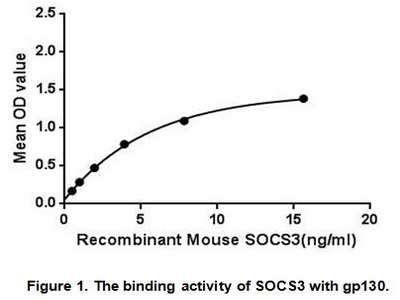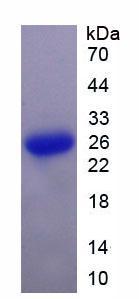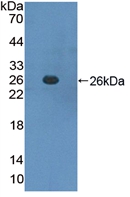
Details
ACTIVITY TEST
Buffer Formulation 20mM Tris, 150mM NaCl, pH8.0, containing 1mM EDTA, 1mM DTT, 0.01% SKL, 5% Trehalose and Proclin300. Traits Freeze-dried powder Purity > 97% Isoelectric Point 8.7 Applications Cell culture; Activity Assays.

Suppressor of cytokine signaling 3 (SOCS3) is a member of the STAT-induced STAT inhibitor (SSI), also known as suppressor of cytokine signaling (SOCS), family that negatively regulates cytokine signal transduction. SOCS3 is feedback inhibitors of the Janus kinase (JAK) and signal transducer and activator of transcription (STAT) signaling pathway. Inhibits cytokine signal transduction by binding to tyrosine kinase receptors including gp130, LIF, erythropoietin, insulin, IL12, GCSF and leptin receptors. SOCS3 also can bind to JAK2 kinase inhibits its kinase activity and nhibits insulin signaling in adipose tissue and the liver. Besides, Glycoprotein 130 (gp130) has been identified as an interactor of SOCS3, thus a binding ELISA assay was conducted to detect the interaction of recombinant mouse SOCS3 and recombinant mouse gp130. Briefly, SOCS3 were diluted serially in PBS, with 0.01% BSA (pH 7.4). Duplicate samples of 100uL were then transferred to SOCS3-coated microtiter wells and incubated for 2h at 37℃. Wells were washed with PBST and incubated for 1h with anti-SOCS3 pAb, then aspirated and washed 3 times. After incubation with HRP labelled secondary antibody, wells were aspirated and washed 3 times. With the addition of substrate solution, wells were incubated 15-25 minutes at 37℃. Finally, add 50µL stop solution to the wells and read at 450nm immediately. The binding activity of of SOCS3 and gp130 was shown in Figure 1, and this effect was in a dose dependent manner.
USAGE
Reconstitute in 20mM Tris, 150mM NaCl (pH8.0) to a concentration of 0.1-1.0 mg/mL. Do not vortex.
STORAGE
Avoid repeated freeze/thaw cycles. Store at 2-8°C for one month. Aliquot and store at -80°C for 12 months.
STABILITY
The thermal stability is described by the loss rate. The loss rate was determined by accelerated thermal degradation test, that is, incubate the protein at 37°C for 48h, and no obvious degradation and precipitation were observed. The loss rate is less than 5% within the expiration date under appropriate storage condition.
Image

SDS-PAGE Image

Figure. Western Blot; Sample: Recombinant SOCS3, Mouse.
Partial purchase records(bought amounts latest0)
User Comment(Total0User Comment Num)
- No comment


 +86 571 56623320
+86 571 56623320




